ST Microelectronics S R L ZB32C2 ZigBee Module User Manual
ST Microelectronics S.R.L. ZigBee Module
User manual
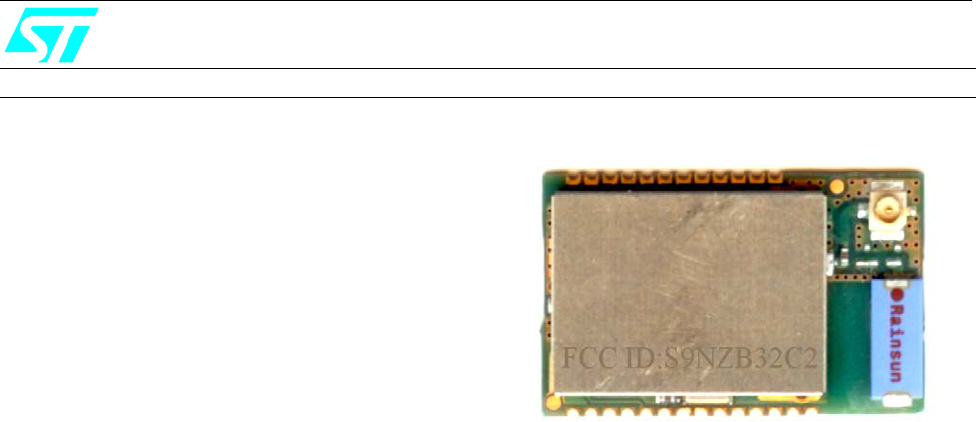
SPZB32W1A2.1 / SPZB32W1C2.1
IEEE 802.15.4 Module
Tentative
FEATURES
• Integrated 2.4GHz , IEEE 802.15.4-compliant
transceiver
• 3 dBm nominal TX output power
• -99 dBm RX sensitivity
• RX filtering for co-existence with IEEE
802.11g and Bluetooth devices
• Integrated VCO and loop filter
• Integrated IEEE 802.15.4 PHY and MAC
• 128kB Embedded flash and 8kB integrated RAM
for program and data storage
• 22 GPIO with alternate functions:
• GPIOs
• UART
• I2C
• SPI
• ADC
• 2 16-bit general purpose timers; one 16-bit sleep
timer
• ADC , sigma-delta converter with 12 bit resolution
• On board 24 MHz stable Xtal
• Selectable Integrated RC oscillator ( typ 10KHz)
or 32.768kHz Xtal for low power operation
• 0.8 uA typ power consumption in Deep sleep
mode
• Watchdog timer and power on reset
• Pins available for Non-intrusive debug interface
(SIF)
• Integrated Antenna (SPZB32W1A2.1) or
integrated RF UFL connector for external antenna
(SPZB32W1C2.1)
• Single voltage supply
• FCC and CE compliant
• Small Form Factor : 16.4 x 26.5 mm
APPLICATIONS
• Industrial controls
• Sensor Networking
• Monitoring of remote systems
• Home/Building Automation
• Security systems
• Lighting controls
DESCRIPTION
SPZB32W1A2.1 / SPZB32W1C2.1 are ready-to-use
ZigBee ® modules optimized for embedded applications
requiring short range performances. These high-
performance, very compact modules enable OEMs to easily
add short range reach wireless capability to electronic
devices by optimizing time-to-market, cost and size of their
target applications.
The modules are based on STM32W single chip ZigBee®
solution which integrates a 2.4GHz, IEEE 802.15.4-
compliant transceiver together with an embedded
processor.
24 MHz high stability Xtal is available aboard the modules
to perform the timing requirements as per ZigBee ®
specifications; additionally a 32.768kHz Xtal is provided
for low power operation.
A single supply voltage is requested to power the modules.
An innovative 2.5 GHz RF design and the relevant internal
RF Amplifier aboard ensure the optimal exploitation of the
link budget, an excellent sensitivity and still low power
consumption for battery powered operation.
The voltage supply also determines the I/O ports level
allowing an easy interface with additional peripherals.
A 128kB of embedded flash memory and 8kB of RAM are
available for data and program storage.
To support user defined applications, a number of
peripherals such as GPIO,UART,I2C, ADC and general
purpose timers are available and user selectable.
Modules are available with two different antenna options:
• SPZB32W1A2.1 with integrated ceramic
antenna aboard
• SPZB32W1C2.1 with UFL RF connector for
the connection of an external antenna.
(for details on STM32W refer to the related Datasheet )

SPZB32W1A2.1 / SPZB32W1C2.1
2/12
Contents
1 Block diagram ……………………………………………………………………………. 3
2 Pin Configuration …………………………………………………………………………3
3 Electrical Characteristics ………………………………………………………………. 4
3.1 Absolute Maximum Ratings …………………………………………………………… 4
3.2 Recommended Operating Conditions ……..…………………………………………… 4
3.3 DC Electrical characteristics …………………………………………………………… 4
3.4 Digital I/O Specifications …………………………………………………………….. 4
3.5 RF Electrical characteristics …………………………………………………………… 4
4 Pins Description …………………………………………………………………………5
5 Mechanical Dimensions ………………………………………………………………….. 8
6 Soldering ………………………………………………………………………………….. 9
7 Appendix A - FCC Statement ..……………………………………………………… 10
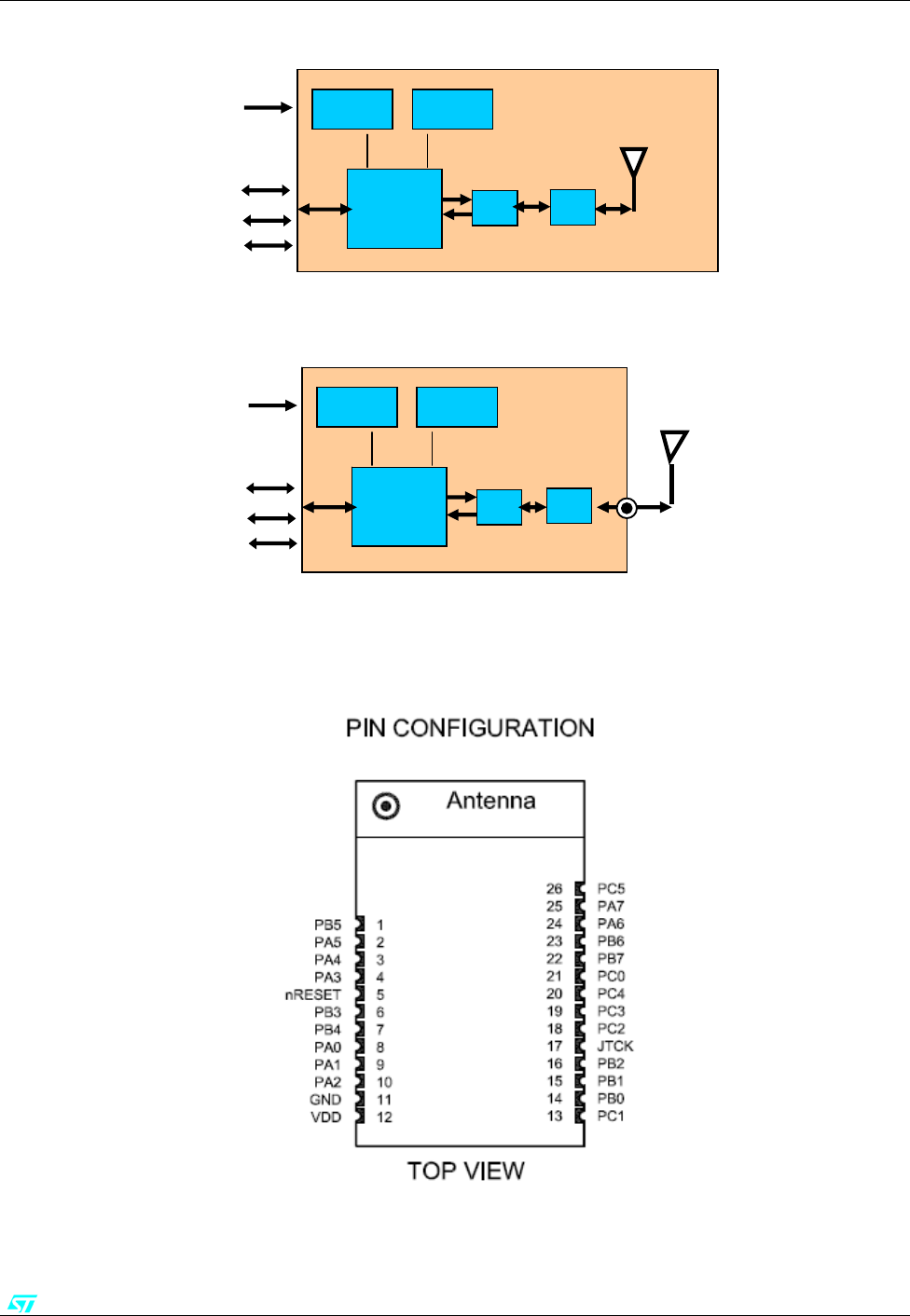
SPZB32W1A2.1 / SPZB32W1C2.1
3/12
1-BLOCK DIAGRAM
2-PIN CONFIGURATION
24 MHz
Xtal
STM32W
Tranceiver
Vdd
SIF
GPIO
CONTR SIGN
RF
antenna
32.768 kHz
Xtal
balun BPF
Figure 1. SPZB32W1A2.1 Block diagram
Figure3. Pin configuration
24 MHz
Xtal
STM32W
Tranceiver
Vdd
SIF
GPIO
CONTR SIGN
RF
antenna
32.768 kHz
Xtal
balun BPF
Figure 2. SPZB32W1C2.1 Block diagram
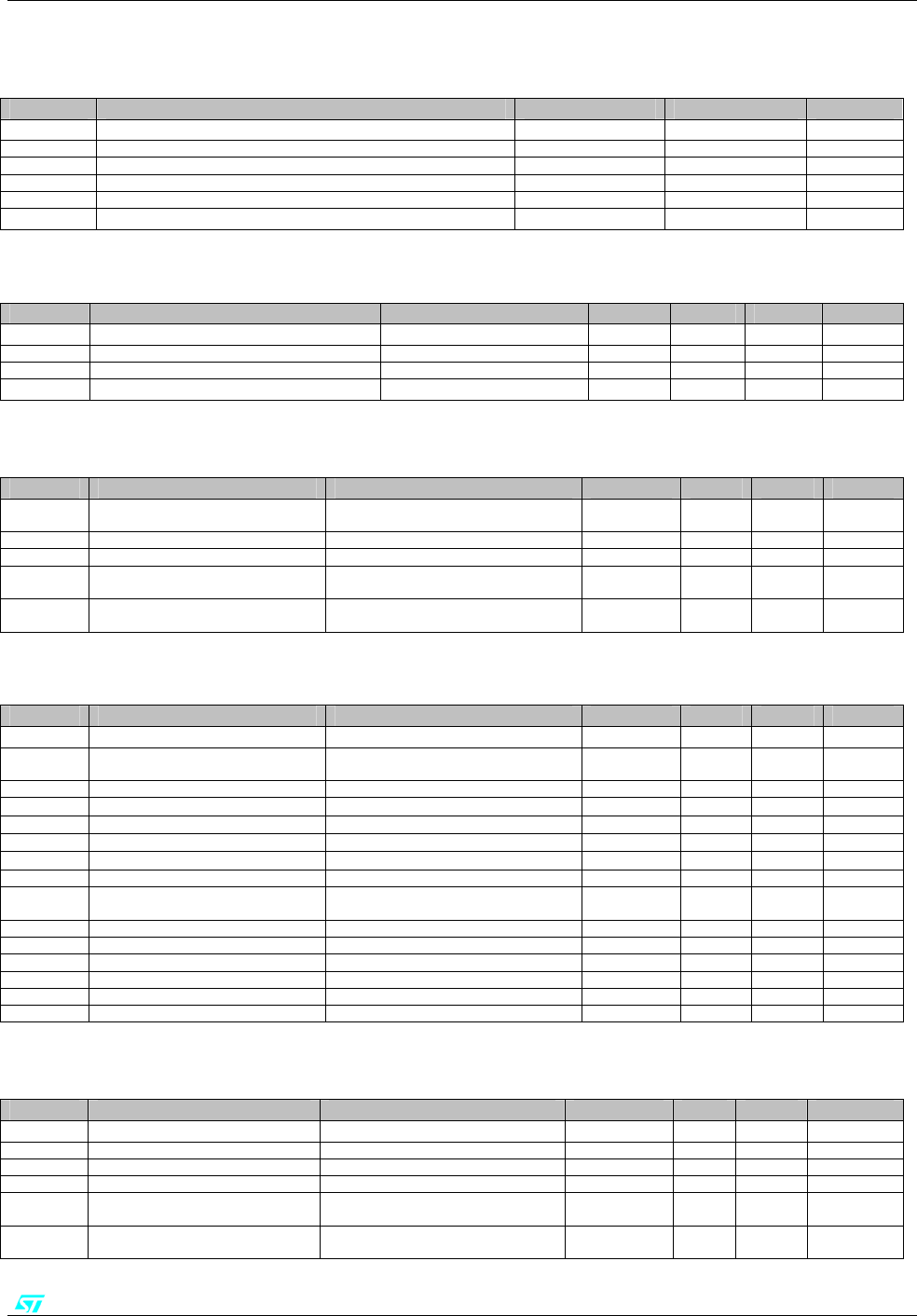
SPZB32W1A2.1 / SPZB32W1C2.1
4/12
3 – ELECTRICAL CHARACTERISTICS
3.1 - ABSOLUTE MAXIMUM RATINGS
Table 1. Absolute maximum ratings
Symbol Parameter Min Max Unit
VDD Module supply voltage - 0.3 3.6 V
Vin Input voltage on any digital pin - 0.3 Vdd + 0.3 V
Tstg Storage tempeature -40 +85 °C
Tsold. Soldering temperature < 10s 250 °C
3.2 - RECOMMENDED OPERATING CONDITIONS
Table 2. Recommended operating conditions
Symbol Parameter Conditions Min Typ Max Unit
VDD Module supply voltage -40°C < T < +85 C 2.8 3.3 3.6 V
Tstg Operating ambient temperature -40 +85 °C
3.3 - DC ELECTRICAL CHARACTERISTICS
Table3. DC Electrical Characteristics
Symbol Parameter Conditions Min Typ Max Unit
IRX RX current Vdd = 3.3 V T= 25 °C 28 mA
ITX TX current Po = 3 dBm Vdd = 3.3 V T= 25 °C
F=2450 Mhz 32 mA
IDS Deep Sleep Current (32.768kHz
oscillator) Vdd = 3.3 V T = 25°C 1.3 µΑ
3.4 - DIGITAL I/O SPECIFICATIONS
Table 4. Digital I/O Specifications
Symbol Parameter Conditions Min Typ Max Unit
VIL Low Level Input Voltage 2.8 < Vdd < 3.6 V 0 0.5 x
Vdd V
VIH High level input voltage 2.8 < Vdd < 3.6 V 0.62 x Vdd Vdd V
Iil Input current for logic 0 2.8 < Vdd < 3.6 V -0.5
µΑ
Iih Input current for logic 1 2.8 < Vdd < 3.6 V 0.5
µΑ
Ripu Input pull-up resistor 30 κΩ
Ripd Input pull-down resistor 30 κΩ
VOL Low level output voltage 0 0.18 x
Vdd V
VOH High level output voltage 0.82 x Vdd Vdd V
IOHS Output source current (standard ) 4 mA
IOLS Output sink current (standard) 4 mA
IOHH Output source current (high current) 8 mA
IOLH Output sink current (high current) 8 mA
IOTot Total output current for I/O 40 mA
3.5 - RF ELECTRICAL CHARACTERISTICS
Table 5. RF Electrical Characteristics
Symbol Parameter Conditions Min Typ Max Unit
Frequency range Vdd = 3.3 V T= 25 °C 2405 2480 MHz
TX Output power Vdd = 3.3 V T= 25 °C 3 6 dBm
RX Sensitivity Vdd = 3.3V 1% PER -95 - 97 dBm
CFE Carrier frequency error Vd d= 3.3V -40 / + 85 °C
- t.b.d. t.b.d. ppm
Adjacent channel rejection +/- 5 MHz
+/- 10 MHZ 35
40 dBm

SPZB32W1A2.1 / SPZB32W1C2.1
5/12
4 – PIN DESCRIPTION
Table 6. Pin Description
Module
Pin
Number
PIN
Name Direction STM32W
pin Description
1 PB5 I/O 43 Digital I/O
ADC0 Analog 43 ADC Input 0
TIM2CLK I 43 Timer 2 external clock input
TIM1MSK I 43 Timer 1 external clock mask input
2 PA5 I/O 27 Digital I/O
ADC5 Analog 27 ADC Input 1
PTI_DATA O 27 Frame signal of PTI (Packet Trace Interface)
nBOOTMODE I 27 Embedded serial bootloader activation out of reset
TRACEDATA3 0 27 Synchrounus CPU trace data bit 3
3 PA4 I/O 26 Digital I/O
ADC4 Analog 26 ADC Input 0
PTI_EN O 26 Frame signal of PTI (Packet Trace Interface)
TRACEDATA2 O 26 Synchrounus CPU trace data bit 2
4 PA3 I/O 25 Digital I/O
SC2nSSEL I 25 SPI SLAVE SELECT of Serial Controller 2
TIM2_CH2 I/O 25 Timer 2 channel 2 output (or input - Disable remap with TIM2_OR[5])
TRACECLK O 25 Synchrounus CPU trace clock
5 nRESET I 12 Active low reset ( an internal pull-up of 30 kohm typ. is provided)
6 PB3 I/O 19 Digital I/O
UART_CTS I 19 UART CTS handshake of Serial Controller 1
SC1SCLK I/O 19 SPI slaver clock of Serial Controller SC1 / SPI master clock of Serial Controller SC1
TIM2_CH3 I/O 19 Timer 2 channel 3 input / Timer 2 channel 3 output
7 PB4 I/O 20 Digital I/O
UART_RTS O 20 UART RTS handshake of Serial Controller 1
TIM2_CH4 I/O 20 Timer 2 channel 4 input / Timer 2 channel 4 output
SC1nSSEL I 20 SPI slave select of Serial Controller 1
8 PA0 I/O 21 Digital I/O
SC2MOSI O 21 SPI Master data out of Serial Controller 2
SC2MOSI I 21 SPI Slave data in of Serial Controller 2
TIM2_CH1 I/O 21 Timer 2 channel 1 input / Timer 2 channel 1 output
9 PA1 I/O 22 Digital I/O
SC2MISO I 22 SPI Master data in of Serial Controller 2
SC2MISO O 22 SPI Slave data out of Serial Controller 2
SC2SDA I/O 22 TWI (I2C) data of Serial Controller 2
TIM2_CH3 I/O 22 Timer 2 channel 3 input / Timer 2 channel 3 output
10 PA2 I/O 24 Digital I/O
SC2SCLK O 24 SPI Master clock of Serial Controller 2
SC2SCLK I 24 SPI Slave clock of Serial Controller 2
SC2SCL I/O 24 TWI (I2C) clock of Serial Controller 2

SPZB32W1A2.1 / SPZB32W1C2.1
6/12
TIM2_CH4 I/O 24 Timer 2 channel 4 input / Timer 2 channel 4 output
11 GND -- 49 Ground
12 VDD Power 16,23,28,37 Input power supply
13 PC1 I/O 38 Digital I/O
ADC3 Analog 38 ADC Input 3
SWO O 38 Serial Wire Output ayncronous trace output to debugger
TRACEDATA0 O 38 Syncronous CPU trace data bit 0
14 PB0 I/O 36 Digital I/O
VREF (O/I) Analog 36 ADC reference output / ADC reference input
TIM1CLK I 36 Timer 1 external clock input
TIM2MSK I 36 Timer 2 external clock mask input
IRQA I 36 External interrupt source A
TRACECLK O 36 Syncronous CPU trace clock
15 PB1 I/O 30 Digital I/O
SC1TXD O 30 UART transmit data of Serial Controller 1
SC1MOSI /
SC1MISO O 30 SPI master data out of Serial Controller 1 / SPI slave data out of Serial Controller 1
SC1SDA I/O 30 TWI (I2C) data of Serial Controller 1
TIM2_CH1 I/O 30 Timer 2 channel 1 input / Timer 2 channel 1 output
16 PB2 I/O 31 Digital I/O
SC1RXD I 31 UART receive data of Serial Controller 1
SC1MISO /
SC1MOSI I 31 SPI master data in of Serial Controller SC1 / SPI slave data in of Serial Controller 1
SC1SCL I/O 31 TWI (I2C) clock of Serial Controller 1
TIM2_CH2 I/O 31 Timer 2 channel 2 input / Timer 2 channel 2 output
17 JTCK I 32 JTAG clock input from debugger
SWCLK I/O 32 Serial Wire clock input/output with debugger
18 PC2 I/O 33 Digital I/O
JTDO O 33 JTAG data out to debugger
SWO O 33 Serial Wire Output asyncronous trace output to debugger
19 PC3 I/O 34 Digital I/O
JTDI I 34 JTAG data in from debugger
20 PC4 I/O 35 Digital I/O
JTMS I 35 JTAG mode select from debugger
SWDIO I/O 35 Serial Wire bidirectional data to/from debugger
21 PC0 I/O 40 Digital I/O (high current)
JRST I 40 JTAG reset input from debugger
TRACEDATA1 O 40 Syncronous CPU trace data bit 1
IRQD I 40 External interrupt source D
22 PB7 I/O 41 Digital I/O
TIM1_CH2 O 41 Timer 1 channel 2 output
TIM1 _CH2 I 41 Timer 1 channel 2 input
IRQC I 41 External interrupt source C
ADC2 I 41 ADC input 2
23 PB6 I/O 42 Digital I/O
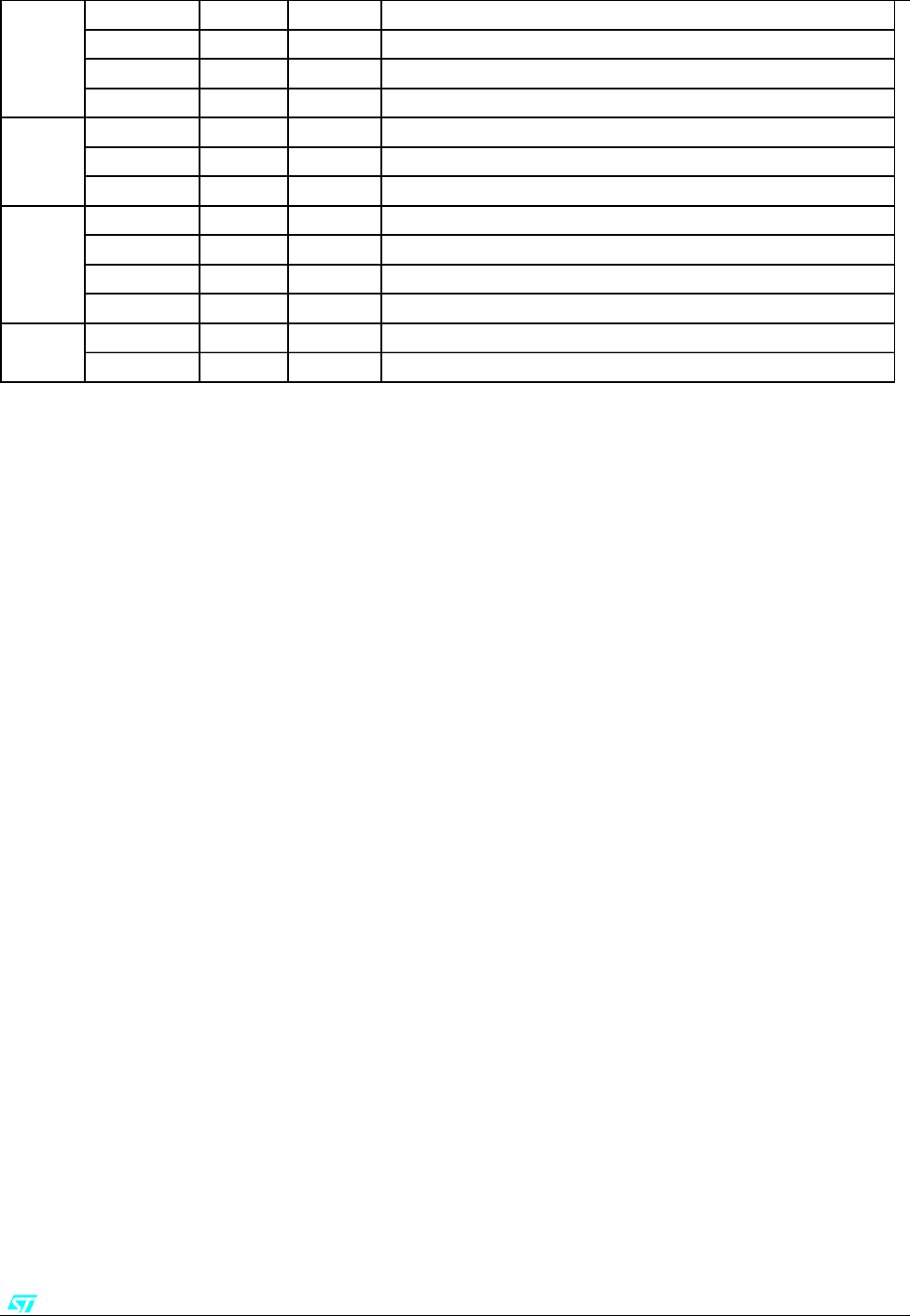
SPZB32W1A2.1 / SPZB32W1C2.1
7/12
TIM1_CH1 O 42 Timer 1 channel 1 output
TIM1_CH1 I 42 Timer 1 channel 1 input
IRQB I 42 External interrupt source B
ADC1 Analog 42 ADC input 1
24 PA6 I/O 29 Digital I/O
TIM1_CH3 O 29 Timer 1 channel 3 output
TIM1_CH3 I 29 Timer 1 channel 3 input
25 PA7 I/O 18 Digital I/O
TIM1_CH4 O 18 Timer 1 channel 4 output
TIM1_CH4 I 18 Timer 1 channel 4 input
REG_EN O 18 External regulator open drain output (enabled after reset)
26 PC5 I/O 11 Digital I/O
TX_ACTIVE O 11 Logic level control for external Rx/Tx switch
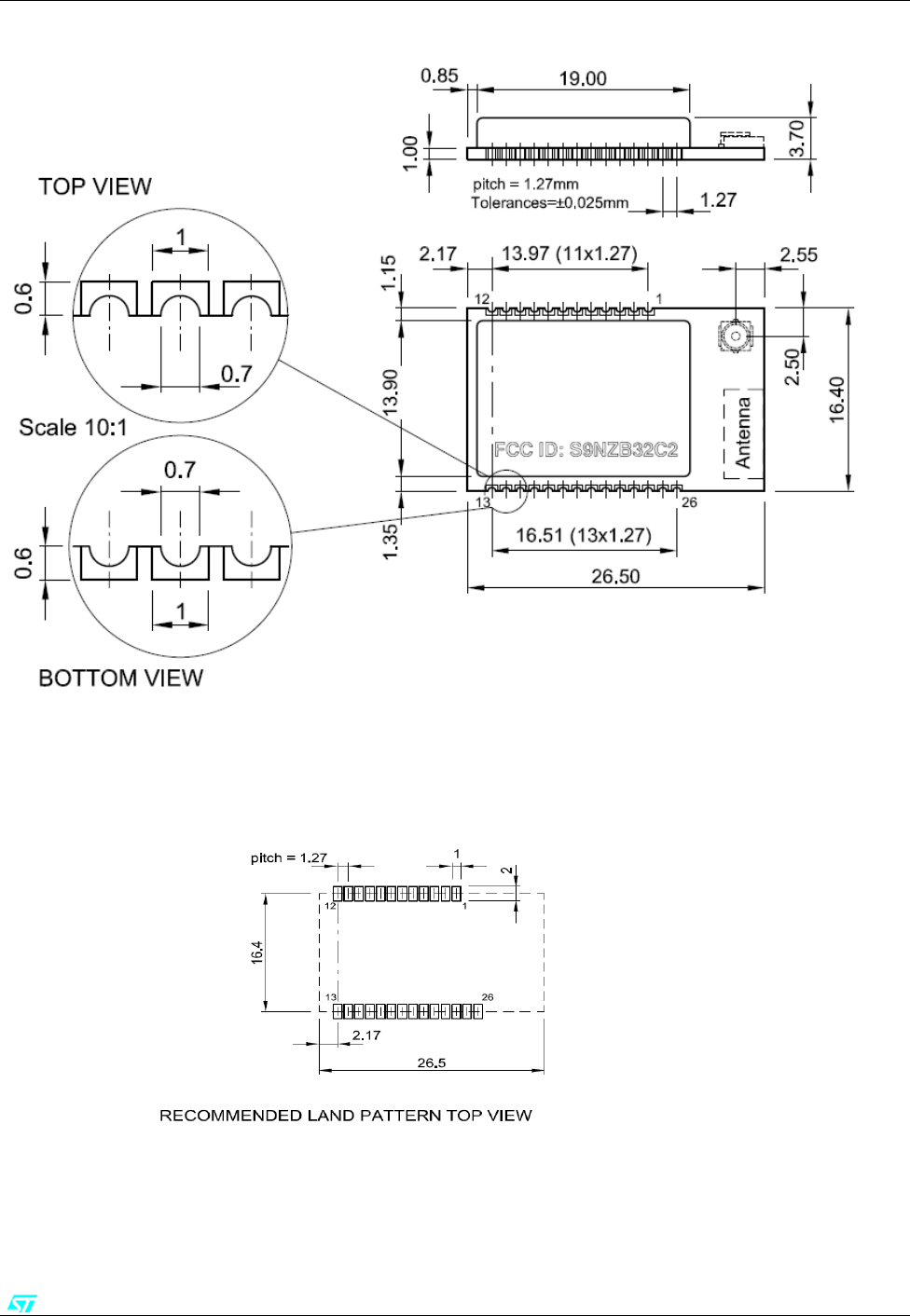
SPZB32W1A2.1 / SPZB32W1C2.1
8/12
5 - MECHANICAL DIMENSIONS
Figure 4 Mechanical dimensions
Figure 5 Pin land pattern
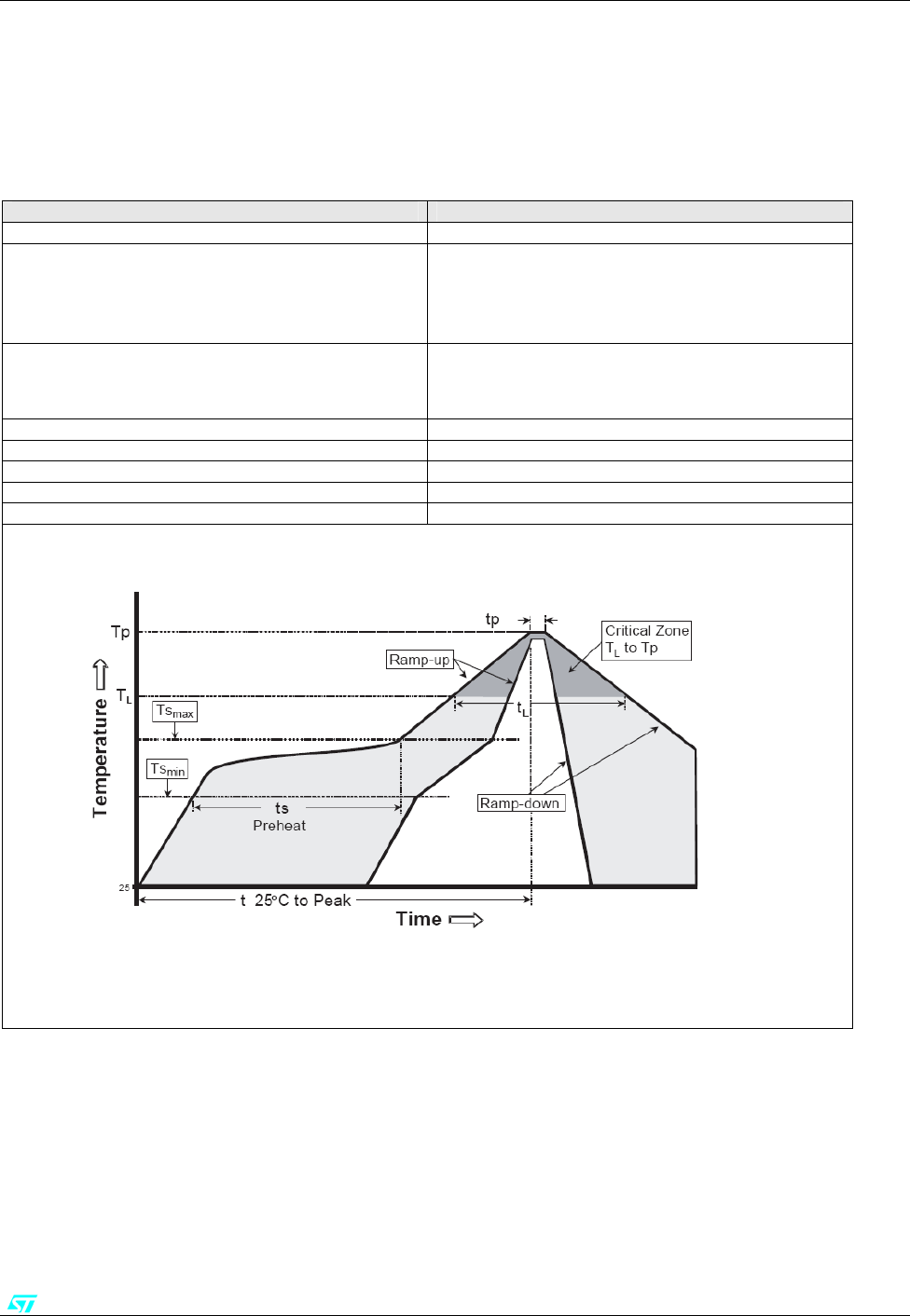
SPZB32W1A2.1 / SPZB32W1C2.1
9/12
6 - SOLDERING
Soldering phase has to be carefully executed: in order to avoid undesired melting phenomenon, particular attention has to be
taken on the set up of the Peak Temperature.
Here following some suggestions for the temperature profile based on IPC/JEDEC J-STD-020C, July 2004 recommendations
Profile feature PB free assembly
Average ramp up rate ( TSMAX to TP) 3°C / sec max
Preheat
Temperature min ( TS MIN)
Temperature max ( TS MAX)
Time (TS MIN to TS MAX) ( tS )
150 ° C
200 ° C
60 – 100 sec
Time maintained above :
Temperature TL
Time tL
217 ° C
40 – 70 sec
Peak Temperature (Tp) 240 + 0 ° C
Time within 5°C of actual peak temperature (tP) 10 – 20 sec
Ramp down rate 6 °C / sec
Time from 25° C to peak temperature 8 minutes max

SPZB32W1A2.1 / SPZB32W1C2.1
10/12
Appendix A - FCC Statement
This device complies with Part 15 of the FCC Rules. Operation is subject to the following two
conditions: (1) this device may not cause harmful interference, and (2) this device must accept
any interference received, including interference that may cause undesired operation.
NOTE: This equipment has been tested and found to comply with the limits for a Class B
digital device, pursuant to Part 15 of the FCC Rules. These limits are designed to provide
reasonable protection against harmful interference in a residential installation. This equipment
generates, uses and can radiate radio frequency energy and, if not installed and used
in accordance with the instructions, may cause harmful interference to radio communications.
However, there is no guarantee that interference will not occur in a particular installation.
If this equipment does cause harmful interference to radio or television reception, which
can be determined by turning the equipment off and on, the user is encouraged to try to correct
the interference by one or more of the following measures:
− Reorient or relocate the receiving antenna
− Increase the separation between the equipment and receiver
− Connect the equipment into an outlet on a circuit different from that to which the receiver
is connected
Consult the dealer or an experienced radio/TV technician for help
Antenna
Our module type SPZB32W1x2.1 is for OEM integrations only. The end-user product will be
professionally installed in such a manner that only the authorized antennas are used.
Caution
Any changes or modifications not expressed approved by the part responsible for compliance could cause the
module to cease to comply with FCC rules part 15, and thus void the user’s authority to operate the equipment.
.
A.1 - LABEL INSTRUCTION
INSTRUCTION MANUAL FOR FCC ID LABELING
Module type : ZigBee® module SPZB32W1A2.1 / SPZB32W1C2.1
FCC-ID : S9NZB32C2
This intends to inform you how to specify the FCC ID of our ZigBee module SPZB32W1A2.1 /
SPZB32W1C2.1 on your final product.
Based on the Public Notice from FCC, the product into which our transmitter module is installed must
display a label referring to the enclosed module.
The label should use wording such as “Contains Transmitter module FCC ID: S9NZB32C2 or “Contains
FCC ID: S9NZB32C2 , any similar wording that expressed the same meaning may be use.
It shows an example below
Contains FCC ID: S9NZB32C2

SPZB32W1A2.1 / SPZB32W1C2.1
11/12
A.2 - Special requirement for Modular application
The following requirements are fulfilled:
1) The modular transmitter must have its own RF shielding:
The RF module used on the board fulfils the emission requirements of the FCC rules without additional shielding.
2) The modular transmitter must have buffered modulation/data inputs:
The module has a memory management unit inside of the IC. The processor interfacing with the external application
by means general purpose I/O ( GPIO) , Uart, SPI. The processor interfaces also the RF part of the module
exchanging data and command with it. Inside the processor a flash memory is available to download the customer
application and the ZigBee profiles.
3) The modular transmitter must have its own power supply regulation:
The IC contains an own voltage regulation. In case of changes in the supply voltage VCC (for example caused by
temperature changes or other effects), the internal voltage will be stabilized.
4) The modular transmitter must comply with the antenna requirements of Section 15.203 and 15.204:
The RF module is for OEM (Original Equipment Manufacturer) integration only. The end-user product will be
professionally installed in such a manner that only the authorized antenna is used.
5) The modular transmitter must be tested in a stand-alone configuration:
The RF module was tested in a stand-alone configuration.
6) The modular transmitter must be labelled with its own FCC ID number:
The RF module will be labelled with its own FCC ID number. When the module is installed inside the end-product,
the label is not visible. The OEM manufacturer is instructed how to apply the exterior label.
7) The modular transmitter must comply with any specific rule or operating requirements applicable to the
transmitter and the manufacturer must provide adequate instructions along with the module to explain any such
requirements:
The EUT is compliant with all applicable FCC rules. Detail instructions are given in the product Users Guide.
8) The modular transmitter must comply with any applicable RF exposure requirements.
• Maximum measured power output: 1.90 mW (2.77 dBm )
• Maximum antenna gain: 2.2 dBi (see also FCC test report)
Maximum permissible exposure defined in 47 CFR 1.1310: 1 mW/cm².
The RF module operates at low power level so it does not exceed the Commission’s RF exposure guidelines limits;
furthermore, Spread spectrum transmitters operate according to the Section 15.247 are categorically excluded from
routine environmental evaluation.

SPZB32W1A2.1 / SPZB32W1C2.1
12/12
Please Read Carefully:
Information in this document is provided solely in connection with ST products. STMicroelectronics NV and its subsidiaries (“ST”) reserve
the right to make changes, corrections, modifications or improvements, to this document, and the products and services described herein at any
time, without notice.
All ST products are sold pursuant to ST’s terms and conditions of sale.
Purchasers are solely responsible for choice, selection and use of the ST products and services described herein, and ST assumes no liability
whatsoever relating to the choice, selection or use of the ST products and services described herein.
No license, express or implied, by estoppel or otherwise, to any intellectual property rights is granted under this document. If any part of this
document refers to any third party products or services it shall not be deemed a license grant by ST for the use of such a third party products or
services, or any intellectual property contained therein or considered as a warranty covering the use in any manner whatsoever of such third
party products or services or any intellectual property contained therein.
UNLESS OTHERWISE SET FORTH IN ST’S TERMS AND CONDITIONS OF SALE ST DISCLAIMS ANY EXPRESS OR
IMPLIED WARRANTY WITH RESPECT TO THE USE AND/OR SALE OF ST PRODUCTS INCLUDING WITHOUT
LIMITATION IMPLIED WARRANTIES OF MERCHANTABILITY, FITNESS FOR A PARTICULAR PURPOSE (AND THEIR
EQUIVALENTS UNDER THE LAWS OF ANY JURISDICTION), OR INFRINGEMENT OF ANY PATENT, COPYRIGHT OR
OTHER INTELLECTUAL PROPERTY RIGHT.
UNLESS EXPRESSLY APPROVED IN WRITING BY AN AUTHORIZED ST REPRESENTATIVE, ST PRODUCTS ARE NOT
RECOMMENDED, AUTHORIZED OR WARRANTED FOR USE IN MILITARY, AIR CRAFT, SPACE, LIFE SAVING, OR LIFE
SUSTAINING APPLICATIONS, NOR IN PRODUCTS OR SYSTEMS WHERE FAILURE OR MALFUNCTION MAY RESULT IN
PERSONAL INJURY, DEATH, OR SEVERE PROPERTY OR ENVIRONMENTAL DAMAGE. ST PRODUCTS WHICH ARE
NOT SPECIFIED AS “AUTOMOTIVE GRADE” MAY ONLY BE USED IN AUTOMOTIVE APPLICATIONS AT USER’S OWN
RISK.
Resale of ST products with provisions different from the statements and/or technical features set forth in this document shall immediately void
any warranty granted by ST for the ST product or service described herein and shall not create or extend in any manner whatsoever, any
liability of ST.
St and the ST logo are trademarks or registered trademarks of ST in various countries.
Information in this document supersedes and replaces all information previously supplied.
The ST logo is a registered trademark of STMicroelectronics. All other names are the property of their respective owners.
© 2010 STMicroelectronics - All rights reserved
STMicroelectronics group of companies
Australia – Belgium - Brazil – Canada - China – Czech Republic - Finland - France - Germany - Hong Kong - India – Israel - Italy - Japan -
Malaysia - Malta – Morocco - Singapore - Spain - Sweden - Switzerland - United Kingdom – United States of America
http://www.st.com